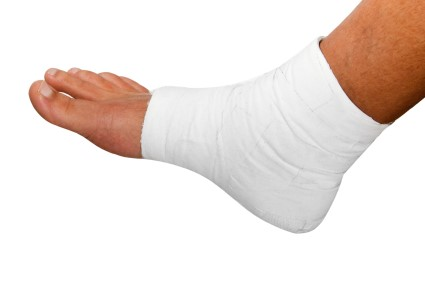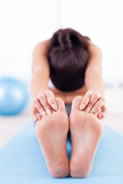Blog
Achilles Tendon Lengthening Procedure Used to Reduce Foot Pain
 George Dawson suffered from pain due to his diabetes for many years and has been dealing with a stiff Achilles tendon due to the pressure placed on his foot. The stiff Achilles tendon meant that the weight was not evenly distributed on his foot and Dawson would need to have the tendon surgically lengthened to relieve the pain and heal properly. Dawson’s podiatrist split his Achilles tendon where it would typically meet the calf muscle, giving it more slack and providing ease to the foot. For nearly two years, George Dawson has not had foot pain since.
George Dawson suffered from pain due to his diabetes for many years and has been dealing with a stiff Achilles tendon due to the pressure placed on his foot. The stiff Achilles tendon meant that the weight was not evenly distributed on his foot and Dawson would need to have the tendon surgically lengthened to relieve the pain and heal properly. Dawson’s podiatrist split his Achilles tendon where it would typically meet the calf muscle, giving it more slack and providing ease to the foot. For nearly two years, George Dawson has not had foot pain since.
Achilles tendon injuries and problems need immediate attention to avoid future complications. If you have any concerns feel free to contact Dr. Michael E. Newman and Dr. Denise Kohler of Pennsylvania. Our doctor will treat your foot and ankle needs.
What is the Achilles Tendon?
The Achilles tendon is a tendon that connects the lower leg muscles and calf to the heel of the foot. It is the strongest tendon in the human body and is essential for making movement possible. Because this tendon is such an integral part of the body, any injuries to it can cause severe difficulties and should immediately be presented to a doctor.
What are the symptoms of an Achilles Tendon Injury?
There are various types of injuries that can affect the Achilles tendon. The two most common are Achilles tendinitis and ruptures of the tendon.
Achilles Tendinitis Symptoms
- Inflammation
- Dull to Severe Pain
- Increased blood flow to the tendon
- Thickening of the tendon
Rupture Symptoms
- Extreme pain and swelling in the foot
- Total immobility
Treatment and Prevention
Achilles tendon injuries are diagnosed by a thorough physical evaluation, which can include an MRI. Treatment involves rest, physical therapy, and in some cases, surgery. However, various preventative measures can be taken to avoid these injuries, such as:
- Thorough stretching of the tendon before and after exercise
- Strengthening exercises like calf raises, squats, leg curls, leg extensions, leg raises, lunges, and leg presses
If you have any questions please feel free to contact our offices located in Plymouth Meeting and Ambler, PA. We offer the newest diagnostic tools and technology to treat your foot and ankle needs.
Study Finds Link between Acne and RA
 According to research conducted by scientists at the Leiden University Medical Centre in Holland, rheumatoid arthritis may be triggered through a microbial infection. Researcher Diahann Jansen has stated that the study shows common bacteria in the flu virus as well as acne. “It doesn’t necessarily mean if you get acne you will get rheumatoid arthritis, but it is possible that if you encounter such a pathogen at some point your immune system will start a response to that pathogen,” stated Jansen. This new discovery is only the beginning in understanding the relationship between microbes and rheumatoid arthritis.
According to research conducted by scientists at the Leiden University Medical Centre in Holland, rheumatoid arthritis may be triggered through a microbial infection. Researcher Diahann Jansen has stated that the study shows common bacteria in the flu virus as well as acne. “It doesn’t necessarily mean if you get acne you will get rheumatoid arthritis, but it is possible that if you encounter such a pathogen at some point your immune system will start a response to that pathogen,” stated Jansen. This new discovery is only the beginning in understanding the relationship between microbes and rheumatoid arthritis.
Understanding where RA starts will help treat and prevent the condition. If you are suffering from rheumatoid arthritis contact, Dr. Michael E. Newman and Dr. Denise Kohler of Pennsylvania. Our doctors will treat your foot and ankle needs.
What Is Rheumatoid Arthritis?
Rheumatoid Arthritis (RA) is an autoimmune disorder in which the body’s own immune system attacks the membranes surrounding the joints. Severe pain and immobility are caused by an inflammation of the lining of your joints, and in worse cases the destruction of the joint’s cartilage and bone can occur.
Rheumatoid Arthritis of the Feet
Although RA usually attacks multiple bones and joints throughout the entire body, many cases result in pain in the foot or ankle area. Pain will often initially present in the toes before the condition worsens and spreads throughout the entire foot.
Symptoms
- Swelling and pain in the feet
- Stiffness in the feet
- Pain on the ball or sole of the feet
- Joint shift and deformation
Diagnosis
Quick diagnosis of RA in the feet is important so that your podiatrist can treat the area effectively. Your doctor may ask you about your medical history and lifestyle to help determine possible causes of your RA.
Treatment
Unfortunately, there is no cure for RA, so treatment options are designed to specifically target the symptoms of it, most notably the pain it causes. Two types of anti-inflammatory drugs – non-steroidal or NSAIDs and corticosteroids – may be prescribed by your doctor. In some severe cases where the joints are too badly damaged, surgery may be an option. As always, speak with your podiatrist to help determine the appropriate treatment options available to you.
If you have any questions please feel free to contact our offices located in Plymouth Meeting and Ambler, PA. We offer the newest diagnostic tools and technology to treat your foot and ankle needs.
The Wide Variety of Running Shoes Today Allows Everyone to Find the Proper Fit
 In the past couple of years, the running shoe market has skyrocketed with nearly thirty-five legitimate running shoe models currently for sale in the United States this year. Experts claim this may be occurring because we live in fitness conscious society where there is a high appeal for running shoes. Since running has become a more accessible form of exercise more people than ever before are interested in purchasing the proper shoe for their foot type.
In the past couple of years, the running shoe market has skyrocketed with nearly thirty-five legitimate running shoe models currently for sale in the United States this year. Experts claim this may be occurring because we live in fitness conscious society where there is a high appeal for running shoes. Since running has become a more accessible form of exercise more people than ever before are interested in purchasing the proper shoe for their foot type.
The right running shoe is essentially different for every person. If you have any concerns feel free to contact Dr. Michael E. Newman and Dr. Denise Kohler of Pennsylvania. Our doctors will treat your foot and ankle needs.
Choosing the Right Running Shoes for Your Foot Type
Running is a physical activity although fun, can put a lot of stress on the joints, bones and ligaments of the body. Injury and stress on the foot can be an important factor on which kind of shoe you’re wearing. Running shoes should be worn based on your foot type. It is important to find out what fits you based on cushioning, stability and motion.
Determining your type
Speak with a shoe specialist or retail professional to see what your foot type is. They will be able to identify and measure your arch type, stride and gait.
Running Mechanics
When you are running or walking in your shoes, every step determines how your foot is landing. Pronation is the natural rolling of your ankle from outside to inside during foot strike.
Pronation is a correct form of walking or running. It helps absorb shock and store energy from your lower extremities. Neutral runners who pronate correctly do not need specific shoes, since they have stability and control.
Over-pronators
Those who run with excessive ankle rolling. Over-pronators tend to have ankles that angle inward, flat feet, and or bowed legs. This can cause a series of injuries: of the knees, ankles and Achilles tendons.
Under-pronation
Under-pronation is less common than over-pronation. This usually happens to those who have inflexible feet and high arches. Even though there is less rotational stress on the ankles and knees, it prevents any kind of shock absorptions. Under-pronation needs shoes with increase in cushion and flexibility.
If you have any questions please feel free to contact our offices located in Plymouth Meeting and Ambler, PA. We offer the newest diagnostic tools and technology to treat your foot and ankle needs.
Australian Surgeons Try Out Less Invasive Surgical Method for Bunions
 Australian surgeons are now practicing minimally invasive surgery for bunions to reduce the amount of pain and recovery time for patients. Michelle Thacker of North South Wales experienced both minimally invasive surgery and traditional bunion surgery for the bunions on her left and right feet. The difference between the two are that minimally invasive surgeries include multiple smaller 3mm incisions with the bunion drilled and realigned with screws; traditional surgeries involve one large incision. After the second bunion surgery involving minimally invasive surgery, Thacker stated, “The recovery time was much quicker - a lot less pain post op, I can barely see a scar and I was able to run after three months.”
Australian surgeons are now practicing minimally invasive surgery for bunions to reduce the amount of pain and recovery time for patients. Michelle Thacker of North South Wales experienced both minimally invasive surgery and traditional bunion surgery for the bunions on her left and right feet. The difference between the two are that minimally invasive surgeries include multiple smaller 3mm incisions with the bunion drilled and realigned with screws; traditional surgeries involve one large incision. After the second bunion surgery involving minimally invasive surgery, Thacker stated, “The recovery time was much quicker - a lot less pain post op, I can barely see a scar and I was able to run after three months.”
Bunion surgery usually occurs after non-surgical methods have proved to be ineffective. If you have any concerns contact Dr. Michael E. Newman of Pennsylvania. Our doctor will treat your foot and ankle needs.
What is a Bunion?
A bunion is formed of swollen tissue or an enlargement of boney growth, usually located at the base joint of the toe that connects to the foot. The swelling occurs by the bones in the big toe shifting inward, which impacts the other toes of the foot. This causes the area around the base of the big toe to become inflamed and painful.
Why do Bunions Form?
- Genetics – susceptibility to bunions are often hereditary
- Stress on the feet – poorly fitted and uncomfortable footwear that places stress on feet, such as heels, can cause bunions to form
How are Bunions Diagnosed?
- Refrain from wearing heels or similar shoes that cause discomfort
- Select wider shoes that can provide more comfort and reduce pain
- Anti-inflammatory and pain management drugs
- Orthotics or foot inserts
- Surgery
Doctors often perform two tests – blood tests and x-rays – when trying to diagnose bunions, especially in the early stages of development. Blood tests help determine if the foot pain is being caused by something else, such as arthritis, while x-rays provide a clear picture of your bone structure to your doctor.
How are Bunions Treated?
If you have any concerns please feel free to contact our offices located in Plymouth Meeting and Ambler, PA. We offer the newest diagnostic tools and technology to treat your foot and ankle needs.
